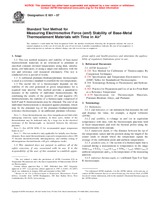We need your consent to use the individual data so that you can see information about your interests, among other things. Click "OK" to give your consent.
ASTM E601-07
Standard Test Method for Measuring Electromotive Force (emf) Stability of Base-Metal Thermoelement Materials with Time in Air
STANDARD published on 1.5.2007
The information about the standard:
Designation standards: ASTM E601-07
Note: WITHDRAWN
Publication date standards: 1.5.2007
SKU: NS-47365
The number of pages: 7
Approximate weight : 21 g (0.05 lbs)
Country: American technical standard
Category: Technical standards ASTM
Annotation of standard text ASTM E601-07 :
Keywords:
ICS Number Code 17.200.20 (Temperature-measuring instruments)
Additional information
| 1. Scope | ||||||||||||
|
1.1 This test method measures emf stability of base-metal thermoelement materials in air referenced to platinum at specified constant elevated temperatures using dual, simultaneous, emf indicators, or using a single emf indicator, with the test and reference emf measured alternately. This test is conducted over a period of weeks. 1.2 A calibrated platinum-rhodium/platinum thermocouple is used as a reference standard to establish the test temperature. 1.3 The useful life of a thermocouple depends on the stability of the emf generated at given temperatures for a required time interval. This method provides a quantitative measure of the stability of individual thermoelements. By combining the results of the positive (P) and negative (N) thermoelements, the stability of a thermocouple comprised of both P and N thermoelements may be obtained. The emf of an individual thermoelement is measured against platinum, which may be the platinum leg of the platinum-rhodium/platinum reference thermocouple, or an additional platinum reference. Note 1Some thermoelements may show insignificant emf drift while undergoing relatively rapid oxidation. In these cases, failure of the thermoelement may be indicated only by a large rise in the electrical resistance of the thermocouple, as measured between the reference junctions. Note 2See ASTM MNL 12 for recommended upper temperature limits in air. Note 3This test method is only applicable for initially new thermoelements. Base-metal thermoelements exposed to temperatures above 200 °C become thermoelectrically inhomogeneous, and stability testing of inhomogeneous thermoelements will give ambiguous results. This standard does not purport to address all of the safety concerns, if any, associated with its use. It is the responsibility of the user of this standard to establish appropriate safety and health practices and determine the applicability of regulatory limitations prior to use. |
||||||||||||
| 2. Referenced Documents | ||||||||||||
|
We recommend:
Technical standards updating
Do you want to make sure you use only the valid technical standards?
We can offer you a solution which will provide you a monthly overview concerning the updating of standards which you use.
Would you like to know more? Look at this page.




 Cookies
Cookies
